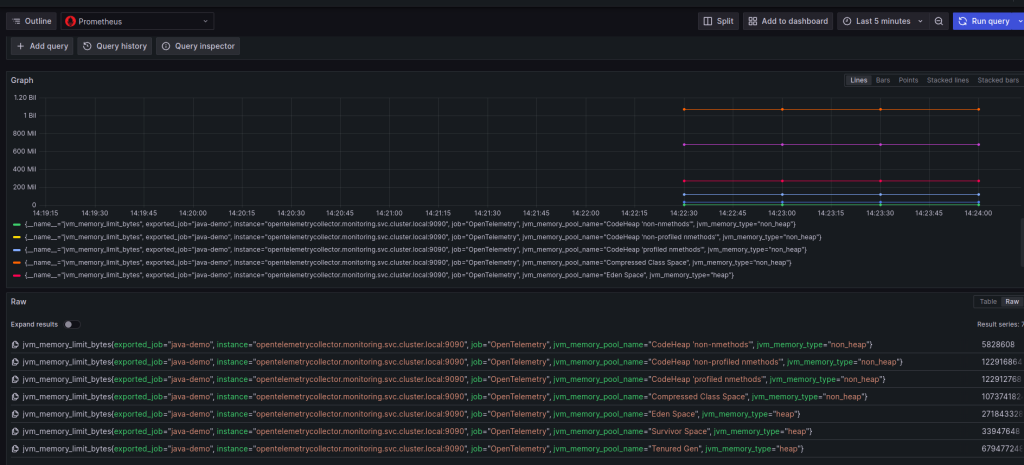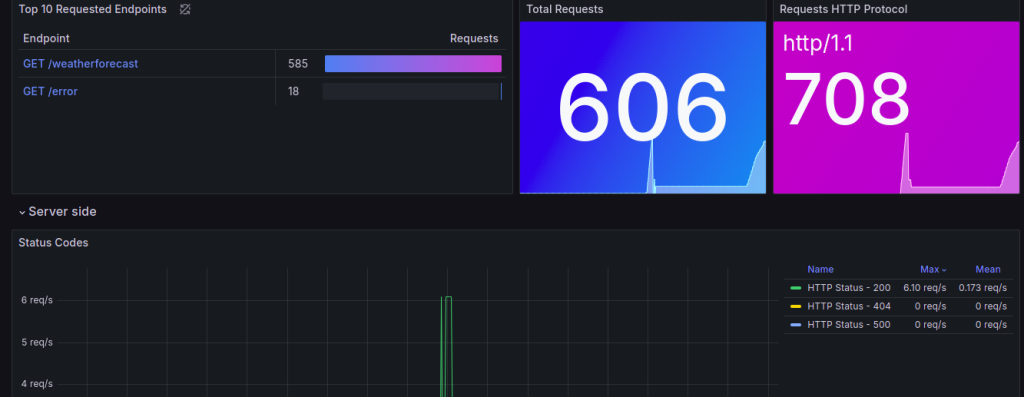Elven Observability: Operator collector (instrumentação automática)
Para que possamos usar o auto-instrumentação devemos instalar o operator do collector
- Dependencies
- Instale o operator
kubectl apply -f https://github.com/open-telemetry/opentelemetry-operator/releases/latest/download/opentelemetry-operator.yaml
- Caso vá instrumentar aplicações Golang:
kubectl -n opentelemetry-operator-system patch deployment opentelemetry-operator-controller-manager \
--type=json \
-p='[{"op": "add", "path": "/spec/template/spec/containers/0/args/-", "value": "--enable-go-instrumentation=true"}]'
É uma prática recomendada enviar telemetria de contêineres para um OpenTelemetry Collector em vez de diretamente para um backend. O Collector ajuda a simplificar o gerenciamento de segredos, desacopla problemas de exportação de dados (como a necessidade de fazer novas tentativas) de seus aplicativos e permite que você adicione dados adicionais à sua telemetria, como com o componente k8sattributesprocessor . Se você optar por não usar um Collector, pode pular para a próxima seção.
https://opentelemetry.io/docs/kubernetes/operator/automatic/
Exemplo de configuracao
apiVersion: opentelemetry.io/v1beta1
kind: OpenTelemetryCollector
metadata:
name: otel
spec:
config:
receivers:
otlp:
protocols:
grpc:
http:
processors:
memory_limiter:
check_interval: 1s
limit_percentage: 75
spike_limit_percentage: 15
batch:
send_batch_size: 10000
timeout: 10s
exporters:
otlp:
endpoint: "tempo-distributor.domain.io:443"
tls:
insecure: false
insecure_skip_verify: true
prometheusremotewrite:
endpoint: https://mimir-distributor.domain.io/api/v1/push
headers:
X-Scope-OrgID: <TENANT>
service:
pipelines:
metrics:
receivers: [otlp]
processors: [batch]
exporters: [prometheusremotewrite]
traces:
receivers: [otlp]
processors: []
exporters: [otlp]
- Aplique o collector
kubectl apply -k otel-collector-operator/
apiVersion: opentelemetry.io/v1alpha1
kind: Instrumentation
metadata:
name: instrumentation-sample
spec:
propagators:
- tracecontext
- baggage
- b3
sampler:
type: parentbased_traceidratio
argument: "1"
env:
- name: OTEL_EXPORTER_OTLP_ENDPOINT
value: otel-collector.monitoring:4318
java:
env:
- name: OTEL_EXPORTER_OTLP_ENDPOINT
value: http://otel-collector.monitoring:4317
Ex. DOTNET
apiVersion: opentelemetry.io/v1alpha1
kind: Instrumentation
metadata:
name: instrumentation-sample
spec:
propagators:
- tracecontext
- baggage
- b3
sampler:
type: parentbased_traceidratio
argument: "1"
env:
- name: OTEL_EXPORTER_OTLP_ENDPOINT
value: otel-collector.default:4318
dotnet:
env:
- name: OTEL_DOTNET_AUTO_METRICS_CONSOLE_EXPORTER_ENABLED
value: "false"
- name: OTEL_DOTNET_AUTO_TRACES_CONSOLE_EXPORTER_ENABLED
value: "false"
- name: OTEL_DOTNET_AUTO_LOGS_CONSOLE_EXPORTER_ENABLED
value: "false"
- name: OTEL_EXPORTER_OTLP_ENDPOINT
value: http://otel-collector.monitoring:4318
- name: OTEL_TRACES_EXPORTER
value: "true"
- name: OTEL_METRICS_EXPORTER
value: "true"
Adicionar anotações a implantações existentes
O passo final é optar por seus serviços para instrumentação automática. Isso é feito atualizando seus serviços spec.template.metadata.annotations para incluir uma anotação específica do idioma:
.NET: instrumentation.opentelemetry.io/inject-dotnet: “true”
Go: instrumentation.opentelemetry.io/inject-go: “true”
Java: instrumentation.opentelemetry.io/inject-java: “true”
Node.js: instrumentation.opentelemetry.io/inject-nodejs: “true”
Python: instrumentation.opentelemetry.io/inject-python: “true”
- Aplicacao test usando auto-instrumentação JAVA
https://opentelemetry.io/docs/kubernetes/operator/automatic/
kubectl apply -f - <<EOF
apiVersion: apps/v1
kind: Deployment
metadata:
name: java-sample
spec:
replicas: 1
selector:
matchLabels:
app: java-sample
template:
metadata:
labels:
app: java-sample
annotations:
instrumentation.opentelemetry.io/inject-java: "true"
spec:
containers:
- name: java-sample
image: emr001/java-app
ports:
- containerPort: 8080
env:
- name: OTEL_SERVICE_NAME
value: "java-demo"
---
apiVersion: v1
kind: Service
metadata:
name: java-app
spec:
selector:
app: java-sample
ports:
- port: 8080
protocol: TCP
targetPort: 8080
---
apiVersion: opentelemetry.io/v1alpha1
kind: Instrumentation
metadata:
name: instrumentation-sample
spec:
propagators:
- tracecontext
- baggage
- b3
sampler:
type: parentbased_traceidratio
argument: "1"
env:
- name: OTEL_EXPORTER_OTLP_ENDPOINT
value: otel-collector.monitoring:4318
java:
env:
- name: OTEL_EXPORTER_OTLP_ENDPOINT
value: http://otel-collector.monitoring:4317
dotnet:
env:
- name: OTEL_DOTNET_AUTO_METRICS_CONSOLE_EXPORTER_ENABLED
value: "false"
- name: OTEL_DOTNET_AUTO_TRACES_CONSOLE_EXPORTER_ENABLED
value: "false"
- name: OTEL_DOTNET_AUTO_LOGS_CONSOLE_EXPORTER_ENABLED
value: "false"
- name: OTEL_EXPORTER_OTLP_ENDPOINT
value: http://otel-collector.monitoring:4318
- name: OTEL_TRACES_EXPORTER
value: "true"
- name: OTEL_METRICS_EXPORTER
value: "true"
EOF
Execute um restart no deployment para o operator inserir o agent via init-container
kubectl rollout restart deployment java-sample
Faça um port-forward na porta 8080 e use o loop abaixo para enviar traces, metricas e logs
kubectl port-forward svc/java-app 8080:8080
Vamos fazer um loop para enviar várias requests
while true; do curl http://localhost:8080/api/hello && echo "" && sleep 1; done
Tracing Grafana

- Aplicacao test usando auto-instrumentação DOTNET
kubectl apply -f - <<EOF
apiVersion: apps/v1
kind: Deployment
metadata:
name: dotnet-sample
spec:
replicas: 1
selector:
matchLabels:
app: dotnet-sample
template:
metadata:
labels:
app: dotnet-sample
annotations:
instrumentation.opentelemetry.io/inject-dotnet: "true"
spec:
containers:
- name: dotnet-sample
image: emr001/dotnet8-app:v1
ports:
- containerPort: 8080
env:
- name: OTEL_SERVICE_NAME
value: "dotnet-demo"
---
apiVersion: v1
kind: Service
metadata:
name: dotnet-app
spec:
selector:
app: dotnet-sample
ports:
- port: 80
protocol: TCP
targetPort: 8080
EOF
Execute um restart no deployment para o operator inserir o agent via init-container
kubectl rollout restart deployment dotnet-sample
Faça um port-forward na porta 8080 e use o loop abaixo para enviar traces, metricas e logs
kubectl port-forward svc/dotnet-app 80:80
Vamos fazer um loop para enviar varias requests
while true; do curl http://localhost/weatherforecast && echo "" && sleep 1; done
while true; do curl http://localhost/error && echo "" && sleep 1; done
Dashboard Grafana
